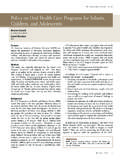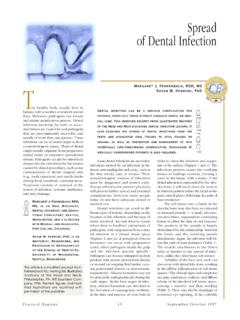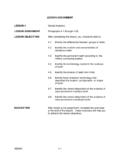Transcription of Multiple congenitally missing primary teeth: …
1 primary teeth oligodontiaPediatric Dentistry 24:2, 2002 Shashikiran et al. 149clinical sectionMultiple congenitally missingprimary teeth : report of a Shashikiran, MDS V. Karthik, MDS Subbareddy, MDS, FICDDr. Shashikiran is professor, Dr. Karthik is a postgraduate student, and Dr. Subbareddy is professor,Department of Pedodontics and Preventive Dentistry, College of Dental Sciences, Davanagere, Karnataka, with Dr. Shashikiran at SectionAbstractThe prevalence, possible etiological factors and management of Multiple missing pri-mary teeth was briefly reviewed. Oligodontia of the primary dentition is a rare paper reports a rare case of Multiple missing (n=9) primary teeth in a 3-year-oldmale of Asian origin.
2 (Pediatr Dent 24:149-152, 2002)KEYWORDS: primary teeth OLIGODONTIAR eceived July 16, 2001 Revision Accepted November 26, 2001 The literature is replete with articles describing thecongenitally missing permanent teeth ; however littlehas been written describing the number, frequencyand location of congenitally missing primary Agen-esis is rare in the primary Indeed, the reductionin number of teeth is concomitant with the reduction in thesize of the jaw in human evolution and believed to be a con-tinuing evolutionary , causes of missing teeth , particularly an-odontia an extreme expression of oligodontia are veryrare and challenging to the Scientific analysis ofthe congenital absence of teeth in humans dates back to Clayton, in 1956,17 collected data from 3,557 full-mouth intraoral radiographs.
3 He reported that 214 childrenin this sample, ranging in age from three to 12 years, had atotal of 433 congenitally missing teeth . Six percent of the214 children were missing more than one tooth. The inci-dence of hypodontia in the primary dentition varies rangingfrom among the Swedish children to among However, a higher incidence of in theprimary dentition of Japanese children has been , in 1967,20 stated that hypodontia of the decidu-ous dentition has always been infrequent. He reported afrequency not exceeding two to six per 1,000 , in 1974,21 investigated 741 British children agedthree to five years, and 1,115 children aged 11 to 14 found the prevalence of hypodontia to be less than 1%with no sex may be missing due to prior extraction or failureto develop or ,22 The most common dental anomalyoccurring in association with congenital absence of thepermanent lateral incisor/second premolar is the absence ofother among primary teeth is a relatively rare oc-currence with a prevalence of less than 1%.
4 Hypodontiausually affects maxillary lateral incisors and mandibular cen-tral and lateral Witkop, in 1965,25 reported that in one Swiss isolate,33% of the population was found to be missing maxillarylateral incisors. Genealogic studies proved that all the af-fected individuals were descendants of one man who hadshown the characteristic in the 18th Century. The classicalfamily study of oligodontia was completed by Grahen in195626 on parents and siblings of 171 persons withhypodontia. He concluded by stating that in the majorityof cases, oligodontia is mainly determined by a dominantautosomal gene pattern with incomplete penetrance of thetrait and variable reportThe patient, a three-year-old Asian male, was referred to thedepartment of Pedodontics and Preventive Dentistry, Col-lege of Dental Sciences, with a chief complaint of missingprimary teeth .
5 The mother gave a history of consanguinousmarriage. The family history regarding the absence of teethwas not significant. Even the siblings had no such intraoral examination revealed the presence of max-illary right and left primary central incisor, maxillary rightand left primary first molar, mandibular right central inci-sor and mandibular right and left primary first molars. Therewas also the presence of ankyloglossia (tongue-tie) and highlabial frenal attachments in the maxillary and mandibularPrimary teeth oligodontia150 Shashikiran et Dentistry 24:2, 2002clinical sectionarches. The alveolus present was also very thin.
6 The teethpresent were of normal size, shape and color (Fig 1).Intraoral periapical radiographs revealed the presence ofmaxillary central incisor tooth buds. There was congenitalabsence of the maxillary right and left primary lateral inci-sors, maxillary right and left primary canines (cuspids),mandibular left primary central incisor, mandibular rightand left primary lateral incisors and canines (cuspids). Theradiographs also revealed unerupted maxillary and mandibu-lar second primary molars (Fig 2).DiscussionThis case is interesting for several reasons. First, there arevery few cases reported in the literature regarding congeni-tal absence of primary teeth , and, in this case, there are atotal of nine missing primary teeth , which in itself is veryrare.
7 Secondly radiographic evidence of this case showed thepresence of the maxillary permanent central incisors the age of three years, usually the permanent maxil-lary central and lateral incisor and mandibular central andlateral incisors tooth buds should be But in thiscase, only the permanent maxillary central incisor tooth budsare present and the other tooth buds are absent. They couldbe formed later or they can be congenitally missing . Thirdly,the patient exhibited ankyloglossia and high frenal attach-ments with very thin alveolar ridges. Certainly this patienthas serious deficiencies and will require long term preven-tive and prosthodontic most common developmental problem with this typeof clinical picture is ectodermal dysplasia.
8 Ectodermal dys-plasia can be classified mainly as:28 (1) hair defect, (2) toothdefect, (3) nail defect, (4) sweating can be classified again into many types based on thecharacteristic features, and few conditions associated withthe absence of teeth ectodermal dysplasia/Anhidrotic ectodermaldysplasia : Is characterized by partial/complete absenceof sweat glands, hypotrichosis and hypodontia. In thiscondition, primary /permanent teeth may be entirelyabsent/few may be present. Incisors and/canines areconical and The conical, pointed teeth arethe key feature of the syndrome and may be the onlyobvious dysplasia: A rare syndrome charac-terized by taurodontic molars, defective enamel anddentin dysplasia.
9 There are few teeth , and widely spacedand deciduous teeth tend to persist. Nails are thin withlongitudinal striations and s tooth and nail syndrome: In this condition, hairis fine and short, the teeth are few and peg shaped andthe nails are thin and and nail dysgenesis: Is characterized by thepresence of few teeth which are conical and widelyshaped. Nails are small, dystrophic/spoon ectodermal dysplasia: This conditionis characterized by precocious eruption and sheddingof deciduous dentition, precocious eruption of second-ary dentition with short, rhomboid roots and short,thin, slow-growing syndrome: Characterized by severehypotrichosis, few, small, conical teeth and hypoplas-tic or absent aerolae.
10 There is cleft lip and extensivetetramelic dysplasia. Growth is , this patient does not have peg-shaped teeth ,dry, scaly skin, straw-like hair, frontal bossing, wide spacedeyes or any problem with body-heat regulation. He appearsto be a perfectly normal young child, with no known fam-ily history of missing teeth . The features in this patient alsoare not consistent with any specific forms of ectodermal is a classical case of oligodontia with Multiple missingprimary teeth . It is a rare case which exemplifies the needfor a thorough diagnosis, when primary teeth are conditions being rare may be the first evidence of amuch more severe problem in the permanent recognition permits long-range planning, implemen-tation of aggressive preventive activities and routinedevelopmental Bennett CG, Ronk SL.














